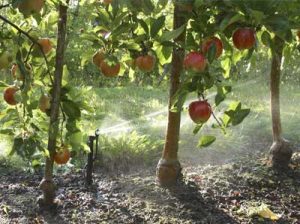 The virtual water footprint of agriculture products is outstanding. What is virtual water? It is the total amount of water used to produce that product. Agricultural uses about 70% of the global water consumption and it takes 125 liters of water to produce just one apple. But did you know that water on crop farms is not just used for the irrigation of the plants?
The virtual water footprint of agriculture products is outstanding. What is virtual water? It is the total amount of water used to produce that product. Agricultural uses about 70% of the global water consumption and it takes 125 liters of water to produce just one apple. But did you know that water on crop farms is not just used for the irrigation of the plants?
When thinking of the term irrigation I think of the need to water a crop to help growth. If you have any sort of garden or house plants you know that they need water to survive. When thinking about irrigation on an apple farm one might think in the same terms. The apple trees get watered when they need water to grow or are “thirsty.” But, this is not always the case.

I grew up on an apple farm and my dad still owns and operates that farm in Washington. The majority of the water used on his apple orchard is for irrigation for the growth of the apple trees but there are other uses. Water is also used during frost season to help keep the trees warm. The sprinklers are turned on and water runs most of the night. There are alternatives, like using a smudge pot which burns oil and creates heat, smoke, and carbon dioxide to keep the trees warm at night but also puts CO2 into the atmosphere. Water is also used during the summer to keep the apples from getting sunburnt. There are pipes that run above the orchard that mist the trees on hot days to keep the apples cool to prevent sunburn. Also, water is mixed with chemicals to form sprays that keep pests off the fruit. Sprinklers are turned on after fertilizers are put around the base of the tree to make sure the fertilizer goes into the soil.
The virtual water of an agricultural product is not just about irrigation, it is most likely going into an array of other things. Extra water use is the alternative to less environmentally friendly actions like the use of smudge pots. The virtual water of an apple is relatively low at 125 liters per apple when compared to a product like a mango that takes 310 liters of water to produce or a watermelon that takes 1,175 liters of water. It is important to remember that to produce these seemingly simple products it takes an abundance of water and that all the food we eat is a form of embodied water.

Image Source
- https://www.agrimgt.com/irrigation-monitoring-and-scheduling/
2. http://betteroffread.com/2013/04/08/blossoms-of-life/smudgepots/
3. https://www.nhbs.com/your-water-footprint-book

Thank you for sharing your experience growing up on an orchard. You raise many interesting concerns I had not taken much time to consider before. I was recently speaking with someone regarding what they do in Arizona to protect plants, in particular fruit trees, from being destroyed by the hot desert sun. She stated that many tree bases are painted white to reflect away the destructive rays. This got me wondering what the possible consequences of painting trees could be on the tree and surrounding environment. Does it affect the animals or the plant itself? Is this better than constant watering, which is the alternative Arizonans attempt to avoid due to more limited water resources? These are all very important considerations for growers and consumers alike.
This is a really interesting, tangible way to think about water use locally. In particular, the details about warming the plants and alternative uses for water outside of irrigation makes you realize the impact of even a (on relative scale) small apple farm. The alternative options have their challenges, and I appreciate you highlighting those. Even though the apple has a small water impact compared to some other fruits and vegetables, I wonder what the local impact is, as a primary crop locally. And I wonder, given that most of the other fruits pictured are grown in tropical climates, how those different ecosystems are impacted in more significant ways (ie. not having the natural water source that we do for so much of the year)?
Thank you so much for the great article, it was fluent and to the point. Cheers.
Do you have a spam problem on this website; I also am a blogger, and I was curious about your situation; we have created some nice methods and we are looking to trade methods with others, please shoot me an email if interested.
Thank you so much for the great article, it was fluent and to the point. Cheers.